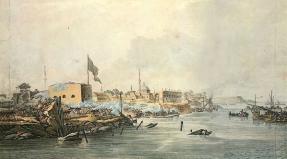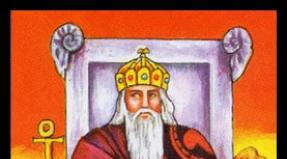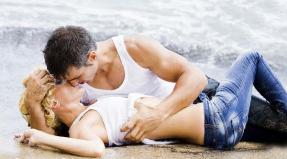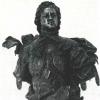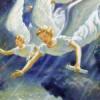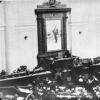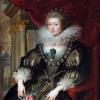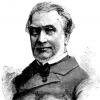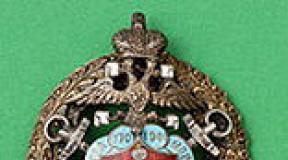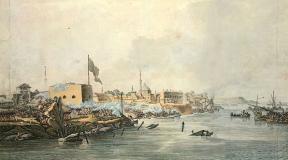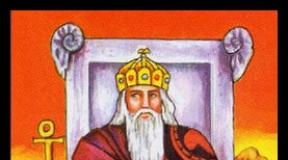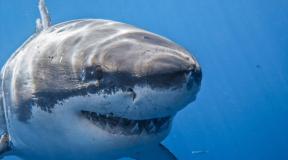Battle of the Cape. Fateful battles. Comparison of enemy forces
Methodological development of a patriotic class hour for students in grades 8-9. Main goals: to expand students’ understanding of the battle at Cape Tendra; develop a sense of patriotism and citizenship, pride in one’s country and people; cultivate a respectful attitude towards the combat pages of Russian history.
Download:
Preview:
Day of military glory of Russia. Battle of Cape Tendra. September 11 - Victory Day of the Russian squadron under the command of F.F. Ushakova over the Turkish squadron at Cape Tendra; occurred on August 28-29 (September 8 – 9), 1790.
The purpose of the teacher's activity:expand students’ understanding of the battle at Cape Tendra; develop a sense of patriotism and citizenship, pride in one’s country and people; cultivate a respectful attitude towards the combat pages of Russian history.
Pedagogical tasks:to form a positive moral assessment of the feat in the name of the Motherland, a positive attitude towards the heroic past of Russia; encourage children to study the military history of Russia.
The first level of educational results and effects of activity:understanding and comprehension of historical events, awareness of their place in history, acquisition of social knowledge by schoolchildren.
Planned results:
Subject: will learn to show a sense of pride in the steadfastness of Russian sailors during the battle at Cape Tendra.
Personal: They show cognitive interest in the educational material, experience moral satisfaction from the results of educational activities, and show a sense of pride and involvement in the past of their country.
Meta-subject (universal learning activities):
Cognitive: general educational – students formulate answers to questions on the topic of the lesson; listen carefully; construct speech utterances orally; logical – improve mental operations;- communicative– students listen and understand by ear the speech of the teacher, classmates, consciously construct speech statements, and share their impressions;- regulatory – accept and save the learning task; plan actions according to the task; exercise control over activities.
Educational Resources:multimedia presentation, photographs and paintings depicting the Russian fleet at Cape Tendra,portrait of F. Ushakov,
Progress of the lesson.
1 Introductory remarks.
Teacher. Russian sailors wrote many heroic pages in the annals of the Russian fleet. They fought for their homeland, defended it from foreign invaders. Many exploits are inscribed in the heroic pages of Russian history, many glorious battles. These battles are marked in the calendar as Days of Military Glory of Russia. And we’ll talk about one of these days today. September 11 - Victory Day of the Russian squadron under the command of F.F. Ushakova over the Turkish squadron at Cape Tendra; occurred on August 28-29 (September 8 – 9), 1790.
2. Main part.
Student 1. Honor of St. Andrew's flag
The cross overshadows
And Russian courage
They know south and west.
And we are ready to remind
How we fought yesterday
And the science of Ushakov,
And Peter's order!
V. Volgar.
Presenter 1. The annexation of Crimea to Russia and the strengthening of the Russian fleet in the Black Sea, after some time, again led to a deterioration in Russian-Turkish relations. In August 1787, Istanbul presented Russia with an ultimatum demanding the return of Crimea and the revision of all previously concluded agreements. These arrogant demands were rejected. At the beginning of September 1787, the Turkish authorities, without an official declaration of war, arrested the Russian ambassador Ya. I. Bulgakov, and the Turkish fleet under the command of the “Crocodile of Sea Battles” Hassan Pasha left the Bosporus in the direction of the Dnieper-Bug estuary. A new Russian-Turkish war began.
Presenter 2. The Russian fleet was greatly inferior in the number of ships: by the beginning of hostilities, the Black Sea Fleet had four battleships, and the Turkish military command had about 20; in the number of corvettes, brigs, transports, the Turks had an approximately 3-4 times superiority.
Student 2. The Turkish fleet was fast,
Three times more ships
And in cannons the strength is superior,
But the battle will show who is stronger?!
L. Leader
Russian battleships were also inferior in quality terms: in speed and artillery armament. In addition, the Russian fleet was divided into two parts. The core of the fleet, mainly large sailing ships, was based in Sevastopol, rowing ships and a small part of the sailing fleet were located in the Dnieper-Bug estuary (Liman flotilla). The main task of the fleet was to protect the Black Sea coast in order to prevent the invasion of enemy troops.
Presenter 3. In March 1790, Ushakov was appointed commander of the Black Sea Fleet. He had to do a lot of work to increase the combat effectiveness of the fleet. Much attention was paid to the training of personnel. The naval commander took ships to sea in any weather and conducted sailing, artillery, boarding and other exercises. Ushakov relied on maneuverable combat tactics and the training of his commanders and sailors. He attached great importance to the “useful opportunity” when the enemy’s indecision, hesitation and mistakes allowed a more proactive and strong-willed commander to win. This made it possible to compensate for the higher number of the enemy fleet and the better quality of enemy ships.
Student 3. Crowning the water element,
Despite death and storms,
He laid it at the feet of Russia,
Keys from the Black Sea!...
L. Leader
Presenter 4. The Turkish command planned in 1790 to land troops on the Caucasian coast of the Black Sea, in Crimea and capture the peninsula. Admiral Hussein Pasha was appointed commander of the Turkish fleet. The threat to the Crimean Peninsula was very significant; there were few Russian troops here. The Turkish landing force, boarded on ships in Sinop, Samsun and other ports, could be transferred and landed in Crimea in less than two days.
Ushakov conducted a reconnaissance campaign along the Turkish coast. Russian sailors captured more than a dozen enemy ships and learned about the preparation of the Turkish fleet with landing forces in Constantinople. Ushakov again took his forces to sea and on July 8 (July 19), 1790, defeated the Turkish squadron near the Kerch Strait. This battle disrupted the landing of enemy troops in the Crimea, showed the excellent training of the crews of Russian ships and the high naval skill of Fyodor Ushakov.
After this battle, the Turkish fleet disappeared into its bases, where intensive work began to restore the damaged ships. The Turkish admiral hid the fact of defeat from the Sultan, declared victory (the sinking of several Russian ships) and began to prepare for a new operation. To support Hussein, the Sultan sent an experienced junior flagship, Seyid Bey.
Presenter 5. On the morning of August 21, the main part of the Turkish fleet was concentrated between Hadji Bey (Odessa) and Cape Tendra. Under the command of Hussein Pasha there was a significant force of 45 ships: 14 battleships, 8 frigates and 23 auxiliary ships, with 1400 guns. At this time, Russian troops began an offensive in the Danube area, and they were supposed to be supported by a rowing flotilla. However, due to the presence of the enemy fleet, the Liman flotilla could not support ground forces.
On August 25, Ushakov took his squadron to sea, it consisted of 10 battleships, 6 frigates, 1 bombardment ship and 16 auxiliary ships, with 836 guns. On the morning of August 28, the Russian fleet appeared at the Tendrovskaya Spit. The Russians discovered the enemy, and the admiral gave the order to approach. For the Turkish Kapudan Pasha, the appearance of Russian ships came as a complete surprise; he believed that the Russian fleet had not yet recovered from the Battle of Kerch and was stationed in Sevastopol. Seeing the Russian fleet, the Turks rushed to quickly cut off the anchors, set the sails and moved in disarray to the mouth of the Danube.
Presenter 6. Russian ships began pursuing the retreating enemy. The Turkish vanguard, led by the flagship of Hussein Pasha, took advantage of the progress and took the lead. Fearing that the lagging ships would be overtaken by Ushakov and pressed to the shore, the Turkish admiral was forced to make a turn. While the Turks were restructuring their formations, the Russian squadron, at a signal from Ushakov, formed three columns into a battle line. Three frigates - “John the Warrior”, “Jerome” and “Protection of the Virgin”, were left in reserve and located at the vanguard in order, if necessary, to suppress the attacking actions of advanced enemy ships. At three o'clock both squadrons went parallel to each other. Ushakov ordered to reduce the distance and open fire on the enemy.
Ushakov, using his favorite tactic - to concentrate fire on the enemy’s flagship (its defeat caused demoralization of the Turkish sailors), ordered a strike on the Turkish vanguard, where the Turkish flagships of Hussein Pasha and Seyid Bey (Seit Bey) were located. The fire of the Russian ships forced the leading part of the enemy fleet to gybe (turn the ships with their bows into the wind) and retreat to the Danube. The Russian squadron drove the Turks and kept up constant fire. By 5 p.m. the entire line of the Turkish squadron was completely defeated. The pursuit continued for several hours, only the onset of darkness saved the Turks from complete defeat. The Turkish ships sailed without lights and constantly changed courses in order to confuse the Russian squadron. However, this time the Turks failed to escape (as was the case during the Battle of Kerch).
Student 4. -Forward! -...calm before the fight,
The guys are invigorated once again,
-Well, brothers, let's meet them with dignity,
It's a pity the wind is against us!...
Student 5. The Turkish fleet, like an omnivorous beast,
-Aiming fire, left...fire!...
Let's divide the squadron in two,
Go around the second one from the side!...
Student 1. The flagship is cut off, the enemy is in confusion,
Such unexpected courage?!
The Turks froze in amazement,
They shout: “They are going to board!”
Student 2. -But no, “friends”, that’s not the case,
Now the right side is burning!
The squadron was dismembered by the enemy,
The farce is over and the enemy is defeated...
L. Leader
Presenter 7. At dawn the next day, the Turkish fleet was discovered on Russian ships, which was “scattered all over different places.” The Turkish command, seeing that the Russian squadron was located nearby, gave the signal to join and withdraw. The Turks took a course to the southeast, and the heavily damaged ships reduced the speed of the squadron and fell behind. One of the Turkish flagships, the 80-gun ship Capitania, brought up the rear of the Turkish formation.
At 10 o'clock in the morning, the Russian ship "Andrey" was the first to overtake the enemy and opened fire on him. The battleships "George" and "Transfiguration of the Lord" came up behind him. They surrounded the enemy flagship and, taking turns, fired salvo after salvo at it. The Turks offered stubborn resistance. At this time, the Russian flagship “Rozhdestvo Khristovo” approached. He stood 60 meters away from the Turks and shot at enemy ships at the closest distance. The Turks could not stand it and “begged for mercy and their salvation.” Seyid Pasha, the captain of the ship Mehmet Darsey and 17 staff officers were captured. The ship could not be saved; due to a fire on board, it soon went up in the air.
At this time, other Russian ships caught up with the enemy 66-gun battleship Meleki-Baghari, blocked it and forced it to capitulate. Then several more ships were captured. In total, more than 700 Turks were captured. According to Turkish reports, the fleet lost up to 5.5 thousand people killed and wounded. The remaining Turkish ships retreated in disorder to the Bosporus. On the way to the Bosphorus, another battleship and several small ships sank. The military skill of the Russian squadron is evidenced by its losses: 46 people killed and wounded.
Student 3. Under the shine of St. Andrew’s flag,
Victory of the Russian sons,
Led a captive squadron,
Turkish enemy ships!
Disciple 4. Noble blood, merciful,
He knew no harm towards the defeated,
Enemy with immeasurable respect,
Nicknamed him “Ushak Pasha”...
Student 5. Victory of valiant battles,
Caring for my country,
He has never experienced defeat!
He lived his life with dignity...
L. Leader
Teacher. A ceremonial meeting was arranged for Fyodor Ushakov’s squadron in Sevastopol. The Russian Black Sea Fleet won a decisive victory over the Turks and made a significant contribution to the overall victory. The northwestern part of the Black Sea was cleared of the enemy Navy, and this opened access to the sea for the ships of the Liman flotilla. With the assistance of the ships of the Liman flotilla, Russian troops took the fortresses of Kiliya, Tulcha, Isakchi and, then, Izmail. Ushakov wrote one of its brilliant pages into the maritime chronicle of Russia. Ushakov’s maneuverable naval battle tactics fully justified themselves; the Turkish fleet ceased to dominate the Black Sea. An outstanding Russian naval commander, an admiral who never knew defeat. canonized by the Russian Orthodox Church.
3. Summing up (reflection).
When did the battle at Cape Tendra take place?
Who commanded the Russian fleet? What are the losses of the parties? Why can you see an icon depicting Fyodor Ushakov in Orthodox churches? Did you manage to realize the scale of this event?
Literature:
Wreath of Glory. An anthology of works of art about the Great Patriotic War in 12 volumes. M. "Contemporary" 1987
A. Mityaev. "The Book of Future Commanders." M. “Young Guard” 1985
O.A. Amelkin. "Days of military glory of Russia." Center for spiritual revival of the Black Earth region. Voronezh - 2005.
S. Istomin. Minin and Pozharsky. Time of Troubles in Rus'. The end of the 16th - beginning of the 17th centuries. - Moscow: White City, 2006.
N. Orlova. Impostors. - Moscow: White City, 2002.
Magazine "Rodina". - No. 11.- 2005
G.P.Popova, N.V.Gritsaeva. Calendar holidays. 5-7 grades. - Volgograd: Teacher, 2007.
I.I. Varakina, S.V. Paretskova. Calendar of memorable dates: cool hours on patriotic themes. 5-11 grades. - Volgograd: Teacher, 2007.
Class hours: 9th grade / Auto-comp. A.V. Davydova. – M.: Vako, 2008.
Class hours: 8th grade/Auto-comp. A.V. Davydova. – M.: Vako, 2008.
Class hours: 5th grade / Auto-comp. A.V. Davydova. – M.: Vako, 2010.
Club hours Problem-based communication, grades 5-6 / Author's compilation. G.V. Bazhenova - Volgograd: Teacher, 2013. L. Kondyrev. Favorites. Poems. Songs. Poems. – M.: “Fiction”, 1973.
OK. Grebenkina and others. Classroom scenarios (part 2). - M.: Center “Pedagogical Search”, 2002.
Parade November 7, 1941. // The Great Patriotic War 1941 - 1945: encyclopedia. - M.: Soviet Encyclopedia, 1985, p. 527.
Parade on November 7, 1941. // Military encyclopedia. - M.: Military Publishing House, 2002. T. 6, p. 256.
Internet materials
225 years ago, on August 28-29 (September 8-9), 1790, the battle took place at Cape Tendra. The Black Sea Fleet under the command of Fyodor Ushakov defeated the Turkish fleet under the command of Hussein Pasha. The victory at Cape Tendra in the military campaign of 1790 ensured the lasting dominance of the Russian fleet in the Black Sea.
September 11 marks one of the Days of Military Glory of Russia - Victory Day of the Russian squadron under the command of F.F. Ushakov over the Turkish squadron at Cape Tendra (1790). It was established by Federal Law No. 32-FZ of March 13, 1995 “On the days of military glory and memorable dates of Russia.”
Background. The struggle for dominance in the Black Sea
During the Russian-Turkish War of 1768-1774. The Crimean Khanate became independent, and then the Crimean Peninsula became part of Russia. The Russian Empire was actively developing the northern Black Sea region - Novorossiya, and began creating the Black Sea Fleet and the corresponding coastal infrastructure. In 1783, construction of a city and port began on the shores of Akhtiarskaya Bay, which became the main base of the Russian fleet on the Black Sea. The new port was named Sevastopol. The basis for the creation of a new fleet was the ships of the Azov flotilla, built on the Don. Soon the fleet began to be replenished with ships built at the shipyards of Kherson, a new city founded near the mouth of the Dnieper. Kherson became the main shipbuilding center in southern Russia. In 1784, the first battleship of the Black Sea Fleet was launched in Kherson. The Black Sea Admiralty was established here.
St. Petersburg tried to accelerate the formation of the Black Sea Fleet at the expense of part of the Baltic Fleet. However, Istanbul refused to allow Russian ships to pass from the Mediterranean to the Black Sea. The Porte thirsted for revenge, and sought to prevent the strengthening of Russia in the Black Sea region, and to return the lost territories. First of all, the Ottomans wanted to return Crimea. To push Russia back from the sea and restore the situation that existed on the southern Russian borders for centuries. In this matter, Turkey was supported by France and England, who were interested in weakening Russia.
The diplomatic struggle between the Ottoman Empire and Russia, which did not subside after the conclusion of the Kuchuk-Kainardzhi Peace, intensified every year. The revanchist aspirations of the Porte were actively fueled by Western European diplomacy. The British and French put strong pressure on Istanbul and called for “not to allow the Russian navy into the Black Sea.” In August 1787, the Russian ambassador in Constantinople was presented with an ultimatum in which the Ottomans demanded the return of Crimea and the revision of previously concluded treaties between Russia and Turkey. Petersburg rejected these arrogant demands. At the beginning of September 1787, the Turkish authorities, without an official declaration of war, arrested the Russian ambassador Ya. I. Bulgakov, and the Turkish fleet under the command of the “Crocodile of Sea Battles” Hassan Pasha left the Bosporus in the direction of the Dnieper-Bug estuary. A new Russian-Turkish war began.
By the beginning of the war, the Russian fleet was significantly weaker than the Ottoman one. Naval bases and a shipbuilding industry were in the process of being established. There were not enough necessary supplies and materials for the construction, armament, equipment and repair of ships. The Black Sea has still been poorly studied. The vast territories of the Black Sea region were at that time one of the far outskirts of the empire, which was in the process of development. The Russian fleet was much inferior to the Turkish in the number of ships: at the beginning of hostilities, the Black Sea Fleet had only 4 battleships, and the Turks had about 20. In terms of the number of corvettes, brigs, and transports, the Turks had an advantage of approximately 3-4 times. Only in terms of frigates, the Russian and Turkish fleets were approximately equal. Russian battleships were also inferior in quality terms: in speed and artillery armament. In addition, the Russian fleet was divided into two parts. The core of the Black Sea Fleet, mainly large sailing ships, was based in Sevastopol, and rowing ships and a small part of the sailing fleet were located in the Dnieper-Bug estuary (Liman flotilla). The main task of the fleet was to protect the Black Sea coast in order to prevent the invasion of the Turkish landing force.
Thus, if Turkey had no advantage over the Russian army on land, then at sea the Ottomans had overwhelming superiority. In addition, the Russian fleet had weak command. Admirals such as N.S. Mordvinov and M.I. Voinovich, although they had the full support of the court and many necessary connections for career development, were not warriors. These admirals were indecisive, inept and lacking initiative, and were afraid of battle. They believed that it was impossible to engage in open battle with an enemy with apparent superiority and adhered to linear tactics.
The Russian fleet was lucky that among the senior officers of the fleet was Fyodor Fedorovich Ushakov, who was decisive and had outstanding military-organizational abilities. Ushakov had no connections at court, was not a well-born aristocrat, and achieved everything with his talent and hard work, devoting his entire life to the fleet. It should be noted that the Commander-in-Chief of the ground and naval forces in the south of the empire, Field Marshal Prince G. A. Potemkin, recognized Ushakov’s talent and supported him.
As a result, the Russian Black Sea Fleet, despite its weakness, was able to successfully resist a strong enemy. In 1787-1788 The Liman flotilla successfully repulsed all enemy attacks, the Turkish command lost many ships. The Turks were unable to use their superiority in large sailing ships with powerful artillery weapons, since a situation developed on the Liman that was reminiscent of the situation on the Baltic skerries during the Northern War, when Tsar Peter’s mobile rowing ships successfully fought the Swedish fleet.
While fierce battles were taking place in the Dnieper-Bug estuary, the main part of the Black Sea Fleet - the Sevastopol squadron - was inactive, being at its base. Rear Admiral Voinovich was afraid of a battle with the superior forces of the Ottomans. The cowardly admiral constantly found reasons not to take the ships to sea. Having been late with the withdrawal of the fleet to sea, he exposed the ships to a strong storm (September 1787). The squadron was repaired for more than six months and was put out of action. Only in the spring of 1788 was combat effectiveness restored. However, Voinovich was again in no hurry to go to sea. Knowing the size of Hassan Pasha's fleet, he was afraid of meeting the Turks and came up with various excuses to delay the squadron's departure to sea. Only after Potemkin’s decisive demands did Voinovich’s squadron go to sea.
On June 18, 1788, the ships left Sevastopol. On the way, the squadron was delayed by a headwind and only 10 days later it reached the island of Tendra. The Ottoman fleet was moving towards. Admiral Hassan Pasha had a huge superiority in forces: against 2 Russian battleships there were 17 Turkish battleships. The Turks had a great advantage in artillery: more than 1,500 guns against 550 Russian cannons. Voinovich was confused and could not lead the Russian ships into battle. At the moment of a decisive meeting with the enemy, he withdrew from the leadership of the Russian squadron, giving the initiative to the commander of the vanguard, the commander of the battleship "Pavel", captain of brigadier rank F.F. Ushakov. For three days, Russian and Turkish ships maneuvered, trying to take a more convenient position for battle. By July 3, both fleets were opposite the mouth of the Danube, near the island of Fidonisi. The Ottomans were able to maintain a windward position, which gave a number of advantages to the ships. However, the Russians defeated significantly superior enemy forces. This was the first baptism of fire for the Sevastopol squadron, the main combat core of the Black Sea Fleet.
This battle had important consequences. Until now, the Ottoman fleet had dominance in the Black Sea, preventing Russian ships from making long voyages. Flights of Russian ships were limited to coastal areas. After this battle, when the Turks retreated for the first time before the Russian squadron on the open sea, the situation changed. If before the battle of Fidonisi many Turkish commanders considered Russian sailors inexperienced and incapable of fighting on the high seas, now it became clear that a new formidable force had appeared on the Black Sea.
In March 1790, Fyodor Ushakov was appointed commander of the Black Sea Fleet. He had to do a lot of work to increase the combat effectiveness of the fleet. Much attention was paid to personnel training and educational work. Ushakov took ships to sea in any weather and conducted sailing, artillery, boarding and other exercises. The Russian naval commander relied on maneuverable combat tactics and the training of his commanders and sailors. He attached great importance to the “useful opportunity,” when the enemy’s indecision, hesitation and mistakes allowed a more proactive and strong-willed commander to win. This made it possible to compensate for the higher size of the Ottoman fleet and the better quality of enemy ships.
After the battle of Fidonisi, the Ottoman fleet did not undertake active operations in the Black Sea for about two years. The Turks built new ships and prepared for new battles. During this period, a difficult situation developed in the Baltic. The British actively encouraged Sweden to oppose Russia. The Swedish elite considered that the situation was very favorable for starting a war with Russia, with the aim of restoring a number of positions in the Baltic that Sweden had lost during the previous Russian-Turkish wars. At this time, St. Petersburg planned to open military operations against Turkey in the Mediterranean Sea, sending a squadron from the Baltic Sea. The Mediterranean squadron was already in Copenhagen when it had to be urgently returned to Kronstadt. Russia had to fight a war on two fronts - in the south and in the northwest. The Russian-Swedish war lasted for two years (1788-1790). The Russian armed forces emerged from this war with honor. The Swedes were forced to abandon their demands. But this conflict greatly depleted the military and economic resources of the Russian Empire, which led to a prolongation of the war with the Porte.
Battle of Cape Tendra
The Ottoman command planned in 1790 to land troops on the Caucasian coast of the Black Sea, in Crimea and recapture the peninsula. The Turkish fleet was commanded by Admiral Hussein Pasha. The threat was serious, since there were few Russian troops in Crimea, the main forces were in the Danube theater. The Turkish landing force, boarded on ships in Sinop, Samsun and other ports, could be transferred and landed in Crimea in less than two days. Turkish troops had a bridgehead in the Caucasus that could be used against Crimea. The forward stronghold of the Ottomans was the powerful fortress of Anapa. From here to Kerch it took only a few hours to reach Feodosia.
Sevastopol closely monitored the situation. Ushakov was actively preparing the ships for the voyage. When most of the ships of the Sevastopol squadron were ready for long-distance voyages, Ushakov went on a campaign with the goal of reconnaissance of enemy forces and disrupting his communications in the southeastern part of the sea. The Russian squadron crossed the sea, reached Sinop and from there passed along the Turkish coast to Samsun, then to Anapa and returned to Sevastopol. Russian sailors captured more than a dozen enemy ships. Then Ushakov again took his ships to sea and on July 8 (July 19), 1790, defeated the Turkish squadron near the Kerch Strait. In terms of battleships, both squadrons were equal, but the Ottomans had twice as many other ships - bombardment ships, brigantines, corvettes, etc. As a result, the Turks had more than 1,100 guns against 850 Russians. However, Admiral Hussein Pasha was unable to take advantage of his superiority. The Turkish sailors wavered under the Russian attack and took to their heels. The best performance of the Turkish ships allowed them to escape. This battle disrupted the landing of enemy troops in Crimea.
After this battle, Hussein Pasha's fleet disappeared into their bases, where the Turks carried out intensive work to restore the damaged ships. The Turkish naval commander hid the fact of defeat from the Sultan and announced victory - the sinking of several Russian ships. To support Hussein, the Sultan sent an experienced junior flagship, Seyid Bey. The Turkish command was still preparing the landing operation.
On the morning of August 21, the main part of the Ottoman fleet was concentrated between Hadji Bey (Odessa) and Cape Tendra. Under the command of Hussein Pasha there was a significant force of 45 ships: 14 battleships, 8 frigates and 23 auxiliary ships, with 1400 guns. The presence of the Turkish fleet restrained the activity of the Liman flotilla, which was supposed to support the offensive of the Russian ground forces.
On August 25, Fyodor Ushakov led the Sevastopol squadron to sea, it consisted of 10 battleships, 6 frigates, 1 bombardment ship and 16 auxiliary ships, with 836 guns. On the morning of August 28, the Russian fleet appeared at Tendra. The Russians discovered the enemy, and Admiral Ushakov gave the order to approach. It came as a complete surprise to the Ottomans; they believed that the Russian fleet had not yet recovered from the Battle of Kerch and was stationed in Sevastopol. Seeing the Russian ships, the Turks rushed to quickly cut off the anchors, set the sails and moved in disarray to the mouth of the Danube.
The Russian squadron pursued the fleeing enemy. The Turkish vanguard, led by the flagship of Hussein Pasha, took advantage of the progress and took the lead. Fearing that the lagging ships would be overtaken by Ushakov, pressed to the shore and destroyed, the Turkish admiral was forced to make a turn. While the Turks were rebuilding, the Russian ships, at a signal from Ushakov, formed three columns into a battle line; three frigates remained in reserve. At 3 o'clock in the afternoon both fleets sailed parallel to each other. Ushakov began to close the distance and gave the order to open fire on the enemy. The Russian naval commander used his favorite tactics - he approached the enemy and concentrated fire on the enemy’s flagships. Ushakov wrote: “Our fleet drove the enemy under full sail and beat him incessantly.” The Turkish flagships, on which the fire of Russian ships was concentrated, were hit the hardest.
The chase continued for several hours. In the evening, the Turkish fleet “went out of sight in the darkness of the night.” Hussein Pasha hoped that he would be able to escape pursuit at night, as had already happened during the Battle of Kerch. Therefore, the Turks walked without lights and changed courses to shoot down their pursuers. However, this time the Ottomans were unlucky.
At dawn the next day, the Turkish fleet was discovered on Russian ships, which was “scattered all over in different places.” The Turkish command, seeing that the Russian squadron was located nearby, gave the signal to join and withdraw. The Turks headed southeast. However, the damaged ships noticeably slowed down and fell behind. The admiral's 80-gun ship Capitania brought up the rear. At 10 o'clock in the morning, the Russian ship "Andrey" was the first to approach the main ship of the Turkish fleet and opened fire. The ships "George" and "Preobrazhenie" came up behind him. The enemy ship was surrounded and came under heavy fire. However, the Ottomans stubbornly resisted. Then Ushakov’s ship approached the Capitania. He stood at a pistol shot distance of 60 meters and “in the slightest time inflicted the most severe defeat on him.” The ship was on fire and lost all its masts. The Turks could not withstand the powerful shelling and began to beg for mercy. The fire stopped. They managed to capture Admiral Seyid Bey, the captain of the ship Mehmet and 17 staff officers. A few minutes later, the fire caused the Turkish flagship to blow up. Other ships of the Russian squadron overtook the Turkish 66-gun battleship Meleki-Baghari, surrounded it and forced it to capitulate. The remaining Turkish ships were able to escape.
The battle ended in complete victory for the Russian fleet. In the two-day battle, the Ottomans were defeated, routed and completely demoralized, losing two battleships and several smaller ships. On the way to the Bosphorus, another 74-gun battleship and several small ships sank due to damage. In total, more than 700 people were captured. According to Turkish reports, the fleet lost up to 5.5 thousand people killed and wounded. Turkish ships, as usual, were overcrowded with people; due to regular desertions, excess crews were recruited, plus landing forces. Russian losses were insignificant - 46 people were killed and wounded, which indicates the high military skill of Ushakov’s squadron.
The Russian Black Sea Fleet won a decisive victory over the Ottomans and made a significant contribution to the overall victory. A significant part of the Black Sea was cleared of the Turkish fleet, which opened access to the sea for the ships of the Liman flotilla. With the assistance of the ships of the Liman flotilla, the Russian army took the fortresses of Kiliya, Tulcha, Isakchi and, then, Izmail. Ushakov wrote one of its brilliant pages into the maritime chronicle of Russia. Ushakov’s maneuverable and decisive naval battle tactics fully justified themselves; the Turkish fleet ceased to dominate the Black Sea.
Congratulating the Russian sailors on their victory at Tendra, Commander-in-Chief of the Russian troops Potemkin wrote: “The famous victory won by the Black Sea forces under the leadership of Rear Admiral Ushakov on the 29th day of last August over the Turkish fleet ... serves to the special honor and glory of the Black Sea fleet. May this memorable incident be included in the journals of the Black Sea Admiralty Board to the everlasting remembrance of the brave exploits of the Black Sea Fleet...”
During the war of 1787-1791, the Ottoman Empire hoped to return the territories that had passed to Russia as a result of the previous conflict - Kerch, Azov, Yenikale, Kinburn. In 1783, Crimea was annexed to the Russian Empire.
The highest one read: “The rising rebellion, the true origins of which are not hidden from us, forced us again to fully arm ourselves and to a new detachment of our troops to the Crimea and to the Kuban side, which remain there to this day: for without them peace and silence could not exist.” and the arrangement among the Tatars, when an active trial for many years already proves in every possible way that just as their previous subordination to the Porte was the reason for coldness and strife between both powers, so their transformation into a free region, with their inability to taste the fruits of such freedom, serves as an everlasting for us the worries, losses and toil of our troops.”
Fedor Fedorovich Ushakov.(wikipedia.org)
The 1790 campaign started well for the Turks: the Austrians were defeated at Zhurzha. In the battle of Cape Tendra, the Turkish forces were commanded by Kapudan Pasha Hussein, who had many victories to his name. He had 17 battleships at his disposal at Cape Tendra; The Russians have 10 battleships. In addition, the Turks had 1,500 cannons at their disposal, while the enemy had only 550.

Assault on Ishmael. (wikipedia.org)
The battle at Cape Tendra began at 15:00 on August 28. Fedor Fedorovich Ushakov, who headed the Black Sea Fleet in the spring of 1790, decided to go first. Three frigates were in reserve. The main attack was carried out on the Turkish flagships. Already 2 hours after the start of the battle, it became clear that the advantage was on the side of the Russians - the Turkish ships began to break down.
At Ushakov’s command, the attack was carried out from the shortest distance. The chase did not stop for several hours. Hussein's ships changed course several times to break away from pursuit. The 80-gun ship "Rozhdestvo Khristovo", which had previously participated in the battle of the Kerch Strait, was also chasing the enemy. In the morning it turned out that the ship "Ambrose of Milan" was in the ranks of the enemy. Fortunately, they had not yet had time to raise the flag, and the Turks did not notice the Ambrose. Unnoticed, the ship returned to the Russians. Following the results of this battle, Grigory Potemkin noted: “May this memorable incident be included in the journals of the Black Sea Admiralty Board for the everlasting remembrance of the brave exploits of the Black Sea Fleet.” The Ottoman Empire lost 3 battleships and 3 auxiliary vessels.
The success of the battle at Cape Tendra weakened the Turkish fleet. In December, Suvorov took. During the storming of this fortress, the Turks lost 26 thousand people, 9 thousand were captured, of which two thousand died from wounds. The Russian army received more than 260 guns, 3 thousand pounds of gunpowder, a lot of other ammunition, 400 banners, 12 ferries and 22 light ships. In addition, the city had a lot of rich booty worth 10 million piastres. Suvorov lost 64 officers and 1816 privates, about 3 thousand people were wounded. A total of 4,582 people died during the assault. In July 1791, Fyodor Ushakov took part in the battle of Kaliakria, which ended in the defeat of the Turkish fleet.
The war ended with the signing of the Treaty of Jassy in December 1791; Russia passed, among other things, the territories between the Dniester and the Southern Bug. For Ushakov, the triumph at Cape Tendra was one of 43 victories.
ABSTRACT
on the course “History of Russia”
on the topic: “The Battle of Cape Tendra and the capture of Izmail during the Russian-Turkish War of 1787-1791.”
Naval battle off Cape Tendra
The naval battle at Cape Tendra took place on August 28 - 29 (September 8 - 9), 1790 during the Russian-Turkish war near the sand island Tendra(now Tendrovskaya spit) in the northwestern part of the Black Sea.
During the 1790 campaign, the commander of the Turkish fleet Kapudan Pasha Hussein (Husein) made an attempt to land troops in Crimea and, with the support of the Crimean Tatars, capture and burn Sevastopol. However, when approaching the Crimea, the Turks were met by a Russian squadron under the command of Rear Admiral F. F. Ushakova. July 8, 1790 "against the mouth Yenikalsky Strait and the Kuban River,” as Ushakov himself designated this place, a five-hour battle took place between the Russian and Turkish squadrons, ending in the flight of the enemy, who managed to take his damaged ships with him. This victory eliminated the threat of a Turkish landing in the Crimea and an attack on Sevastopol, and was immediate precursor to the naval battle at Cape Tendra.
After an unsuccessful collision with the Russian squadron of Kapudan Pasha, Hussein decided to adhere to wait-and-see tactics and moved with his fleet to the Ochakov area. The Turkish squadron, consisting of 14 battleships, 8 frigates, 23 auxiliary ships and numbering about 1,400 guns, was significantly superior to Ushakov's squadron, which gave Hussein hope of success in a new battle.
The Russian squadron, consisting of 10 battleships, 6 frigates, 1 bombardier ship and 20 auxiliary ships, numbering about 830 guns, left Sevastopol on August 25 in search of the Turkish fleet. Following in the direction of Ochakov, Ushakov discovered on August 28, near Tendra, Turkish ships of Hussein’s squadron, anchored. The Russian naval commander decided to immediately attack the enemy without rearranging his squadron from marching order to combat order. Taken by surprise, the Turkish ships began to retreat to the mouth of the Danube in disarray. The Russian squadron in three columns attacked the rearguard of the Turkish fleet, trying to cut it off from the main forces. This forced kapudan-pashu, Having lined up the front ships in a battle line, turn back to cover the lagging part of your fleet.
At 15 o'clock, the Russian ships, having approached the enemy within shotgun range, resolutely attacked him.
Unable to withstand the attack, the Turkish ships retreated and, taking advantage of their superior speed, disappeared into the darkness at about 0 o'clock. The ships of the Turkish flagships were especially damaged. With the onset of darkness, the pursuit was stopped, and Ushakov, due to signs of stormy weather, ordered to anchor for the night.
At dawn on August 29, the Russian squadron again discovered Turkish ships and attacked them. Cutting off the anchor ropes, the Turks panicked and tried to break away from the enemy. During the chase, the admiral's ship was overtaken, set on fire and captured. "Captain" and two battleships were destroyed. In addition, on August 29 - 30, during the pursuit, the Russian squadron captured three and destroyed several small Turkish ships. Turkish losses amounted to more than two thousand people, including more than 700 prisoners. The adviser was captured Kapudan Pasha Hussein admiral Said Bey. The Russian fleet had no losses in ships; 21 people were killed and 25 were injured.
The victory in the naval battle at Cape Tendra ensured the lasting dominance of the Russian fleet on the Black Sea in the 1790 campaign and created favorable conditions for active offensive actions by the Russian army and rowing flotilla on the Danube. It was achieved thanks to outstanding naval leadership; the abilities of Admiral F.F. Ushakov, the skill and courage of the officers and sailors of the Russian fleet. In the battle of Tendra, the features of advanced maneuverable tactics of the naval
battle, the creator of which was F.F. Ushakov: the use of a single marching battle formation, approaching the enemy at a short distance without redistributing the marching formation into a combat one, concentrating fire on a decisive object and disabling first of all the enemy’s flagships, conducting combat on range of grape shot and pursuit of the enemy to complete his complete defeat or capture. For the defeat of the Turkish fleet Tendras F. F. Ushakov was awarded op denom St. Geogy II degree.
Capture of Ishmael
December 24, 1790 is considered the day of the capture of the Turkish fortress of Izmail by Russian troops under the command of A.V. Suvorov.
During the Russian-Turkish War of 1787 - 1791, Russian troops under the command of General I.V. Gudovich began offensive operations in the lower reaches of the Danube in the fall of 1790. Having captured a number of strong Turkish fortresses (Kiliya, Tulcha, Ysakcha), the Russian army blocked Izmail from land and from the Danube in November.
The Izmail fortress, called Ordukalen (army fortress) by the Turks, was considered impregnable. After the previous Russian-Turkish war (1768 - 1774), it was rebuilt under the leadership of French and German engineers in accordance with the new requirements of fortification art. The fortress was located on a hill with a steep cliff descending to the Danube. The 6 km long main rampart with seven earthen and stone bastions and four fortified gates encircled the city on three sides. The height of the rampart reached 6-8 m, the fortress moat was 12 m wide and 6 to 10 m deep, in some areas there was water up to 2 m deep. On the southern side, Izmail was protected by the Danube, which is half a kilometer wide here. Inside the city there were many stone buildings convenient for defense. The fortress garrison numbered 38 thousand people and 265 guns. The garrison was commanded by one of the best Turkish generals, Aidos Mehmet Pasha.
The Russian army, numbering 31 thousand people with 500 guns, made two unsuccessful attempts to capture Izmail in November. The military council, assembled by the new commander, General A. N. Samoilov, decided to lift the siege of the fortress due to the approach of winter. Under these conditions, A.V. Suvorov was placed at the head of the Russian army instead of Samoilov.
Having studied the situation, Suvorov decided to storm the fortress. He ordered the units to take their previous positions and organized their careful preparation. To the side of Izmail, fortifications similar to fortresses were built. Here at night, in secret from the Turks, the troops learned to overcome them. For the assault, 30 ladders and a thousand fascines were made. Conducting daily reconnaissance with the heads of the sections, Suvorov carefully studied the defense scheme of Izmail and assigned each of them a specific task. The idea of the assault was a surprise night attack of the fortress from all sides. At the same time, the main efforts were concentrated along the least protected riverine part of Izmail. For this purpose, the troops were divided into three detachments of three columns each. A detachment of the first wing under the command of General P. S. Potemkin was supposed to attack the western facade of the fortress. The detachment of General A. N. Samoilov, one of the columns of which was commanded by M. I. Kutuzov, was on the eastern facade, and the detachment of General O. M. Deribas, with the support of the Liman military flotilla, had the task of attacking the fortress from the south, from the Danube. There were 2.5 thousand Cossacks left in the general reserve of our troops.
Of the nine columns in the main direction in the riverine strip, A.V. Suvorov concentrated six, and here all the artillery of the Liman flotilla and most of the field artillery were massively used. The battle formation of each column included two echelons and a reserve. In the first echelon, up to 150 riflemen and 50 sappers moved, in the second, the main forces of the column (3 battalions), a private reserve (2 infantry battalions, formed in a square) followed at the tail of the column.
The battle formation of the Liman flotilla consisted of two lines. 145 light ships and Cossack boats with landing forces were placed in the first line, and 58 larger ships in the second. Large ships were supposed to cover the landing of troops on the shore with fire from their heavy artillery.
A.V. Suvorov, preparing soldiers for the assault, did not hide from them the difficulties of its implementation. “The walls of Ishmael,” he said, “are high, the ditches are deep, but still we need to take it.” Before the assault, A.V. Suvorov addressed the troops with the following words: “Brave warriors! Bring to mind all our victories this day and prove that nothing can resist the power of Russian weapons... The Russian army besieged Ishmael twice and retreated twice "It remains for us to either settle for the third time or die with glory." At the same time, he warned: “Christians and the disarmed should not be put to death, meaning the same about all women and children.”
Before the assault, A.V. Suvorov sent an official letter to the commander of the Turkish troops in Izmail, Mehmet Pasha, demanding the surrender of the fortress. He attached a note to the letter with the following content: “To Seraskir, the elders and the whole society: I arrived here with the troops. 24 hours to think about surrender and freedom; my first shots are already bondage, the assault is death, which I leave to you for consideration.” Ishmael’s commandant proudly refused: “It would be more likely for the Danube to stop flowing and the sky to bow to the ground than for Ishmael to surrender.”
On December 11 (22), at 3 o'clock, at a signal from rockets, the troops began to concentrate at the points indicated by them and at 5 o'clock 30 minutes, two hours before dawn, observing complete silence, they launched an assault. When approaching the fortress, the columns were met by fire from 250 enemy guns, but they could not hold back their onslaught. The first to ascend the rampart and penetrate the city was the 2nd column of B. Lassi, operating on the right flank, followed by the 1st column of S. Lvov.
On the left wing, the 6th column under the command of M.I. Kutuzov successfully operated, taking the Kiliya Gate. A.V. Suvorov noted: “Major General and Cavalier Golenishchev-Kutuzov showed new experiments in his art and courage, overcoming all difficulties under strong enemy fire, climbed the rampart, captured the bastion, and when the excellent enemy forced him to stop, he, Serving as an example of courage, he held the place, overcame a strong enemy, established himself in the fortress and then continued to defeat the enemies." A.V. Suvorov, observing every step of his subordinates, ordered to “congratulate Kutuzov as commandant of Izmail” and they will add that he has already sent a messenger with the news of the conquest of the fortress. After the assault, M. Kutuzov asked A. Suvorov: “What did this appointment mean?” “Nothing,” answered A. Suvorov, “Kutuzov knows Suvorov, and Suvorov knows Kutuzov. If Izmail had not been taken, Suvorov would have died under its walls and Kutuzov too.”
The breakthrough of three Russian columns into Izmail ensured success in other directions. The battle for the capture of the rampart and bastions continued until 8 o'clock in the morning. The attack was also successful from the Danube. The landing was supported by the fire of naval guns. After the capture of the city fortifications, bloody street battles began. The Turks defended stubbornly. Every street, every square, every stone house, turned into small fortresses, had to be taken with battle. “The day was already palely illuminating the objects,” wrote A.V. Suvorov, recalling that moment of the assault, “all our columns, having overcome enemy fire and all difficulties, were already inside the fortress, but the enemy stubbornly and firmly defended himself. Every step had to be acquired new defeat; many thousands of the enemy fell from our victorious weapons, and his death seemed to revive new strength in him, but strong despair strengthened him."
To complete the defeat of the Turks, Suvorov introduced part of the field artillery, general and private reserves into the city. The fierce battle inside the fortress continued until 16 hours. The Turkish resistance was broken, and Russian troops occupied the fortress. The Turks lost 26 thousand killed and 9 thousand captured in the battle. Among those killed was Seraskir Aidos Mehmet Pasha. The trophies of the winners were 265 guns, 42 ships, 345 banners and 7 horsetails. Russian troops lost 4 thousand killed and 6 thousand wounded.
The capture of Izmail changed the strategic situation in Russia's favor, forcing Turkey to negotiate peace. The assault on the fortress was an outstanding example of an accelerated attack on fortresses by combined actions of ground forces and a river flotilla, as a result of which an army of a numerically superior enemy was destroyed. The success of the assault was ensured by the surprise of the actions, the thoroughness and secrecy of the preparation of the troops, the simultaneity of the strike and the close coordination of actions between the columns. The capture of Izmail was a major contribution to the development of military art. The views on serf war that prevailed in Western Europe in the 18th century, which amounted to a long, methodical siege of fortresses, were refuted. The method of accelerated attack adopted by Suvorov was based on the high moral and combat qualities of the Russian army, skillful engineering and artillery preparation for the assault. The very preparation of the troops for the assault was very instructive, during which Suvorov ensured that every soldier “understood his maneuver.” The management of reserves combined centralization and independence of actions of column commanders. During the assault on Izmail, the tactics of columns and scattered formations, first used by General P. A. Rumyantsev during the capture of Colbert in 1761, were further developed.
1. Klyuchevsky V.O. Historical portraits. M.: 2006
2. Klyuchevsky V.O. Russian history course. M.: 2005
3. Soloviev S.M. Public readings on the history of Russia. M.: 2005
4. Soloviev S.M. About the history of Russia. M.: 2004
5. Collection: Russia during the period of reforms and transformations of the 18th century.: M. 2005.
The time has come to introduce you to a new section on our website - “Days of Military Glory of Russia”.
The first holiday will be September 11 - the Day of Military Glory of Russia. Victory Day of the Russian squadron under the command of F.F. Ushakov over the Turkish squadron at Cape Tendra in 1790.
Location
The first thing that interested me was the location of this cape. To be honest, I had never heard of Cape Tendra before. Googled it. It turned out that it was in the northern part of the Black Sea - in the territory of what is now Crimea and Ukraine, not far from Odessa.
The following is under what circumstances the battle took place and what led to it.
Prerequisites
The battle itself took place as part of the next Russian-Turkish war. It lasted 5 years: from 1787 to 1792. It was preceded by the battle of the Kerch Strait, after which Kapudan Pasha Hussein (commander of this Turkish fleet) retreated to the Turkish shores, patched up the holes of his ships, took with him several battleships - the main striking force of any fleet of that time and returned to the shores of Russia in early August 1790.
On August 17, Hussein Pasha approached the exit from the Dnieper estuary, anchoring his entire fleet between Tendra Island and the coast near Hajibey. This situation allowed the Turkish fleet to block the exit from the Dnieper estuary and keep control of the Liman-Sevastopol communication, important for the Russian fleet, preventing the connection of the Sevastopol naval fleet with new ships from Kherson.
Comparison of enemy forces
The Turkish fleet under the command of Hüseyin Pasha included:
- 14 battleships (up to 1000 guns, up to 10,000 crew).
- 8 frigates (up to 360 guns).
- 23 bombardment ships, small cruisers and floating batteries.
As part of the Russian fleet under the command of Rear Admiral F.F. Ushakov numbered:
- 10 battleships (596 guns).
- 6 frigates (240 guns).
- 1 bombardment ship.
- 1 rehearsal vessel.
- 17 small cruising ships and 2 fire ships.
- The total number of crews reached 7,969 people, including 6,577 people on battleships and frigates.
In general, even with the naked eye one can see that the superiority of power was clearly on the side of the Turks. However, Ushakov would not have become such a great admiral if he had not gone on the attack first.
Don't think that this was a spontaneous decision. One of the principles that helped Fedor Fedorovich win always and everywhere was the following: “Know where the enemy is, in what numbers and what his intentions are.”
Start of the battle
The battle itself began on September 8, 1790 and lasted 2 days. Based on the results of timely reconnaissance, Ushakov knew even before leaving Sevastopol that the enemy forces were superior to the fleet at his command, but this did not prevent the great naval commander from confidently launching the attack first.
By 8 o'clock in the morning on September 8, the Russian fleet was sailing exactly downwind from Sevastopol and became a real contrast shower for Husein Pasha, who could not even think that Ushakov would decide to attack first.
The Russian commander ordered the sails to be increased and, “taking advantage of the enemy’s strong wind and disorder, he hurried to get closer and attack.” The Turkish fleet, having cut off the anchor ropes and set sail in disarray, tried to evade the battle.
But Ushakov, without wasting time on changing into battle formation, pursued the enemy in marching order and at noon created a threat to the lagging ships of the Turkish fleet. Fearing that his rearguard might be cut off from the main forces of the fleet, Kapudan Pasha was forced to turn and began to build a battle line.
At a signal from Fedor Fedorovich, the Russian fleet at 12 o'clock also moved into the battle line and also turned after the Turks, maintaining a windward position. At the same time, he, fearing a counter-offensive if the wind direction changed, ordered the leading three frigates - “John the Warrior”, “Jerome” and “Protection of the Virgin” - to leave the general formation and build a reserve corps.
This formation also made it possible to unite the forward part of the battle line, concentrating at its head 6 battleships with support from those frigates - 68% of all the fleet's guns. A kind of dagger tip was formed, ready to pierce its opponent at the first opportunity.
After this, at the signal “Go down on the enemy,” the Russian fleet approached the Turkish fleet within the distance of a grape shot (less than 100 meters) and at 15 o’clock entered into a fierce battle. Under the fire of Russian ships, the Turks suffered great damage and losses and involuntarily descended into the wind, pursued by a persistent enemy (Ushakov).
At about 16 o'clock, one of the flagship Turkish ships - an advanced 80-gun ship, which was also extremely fast, took the lead and, turning around, tried to win the wind in order to hit the lead ship of the Russian fleet, St. George the Victorious, with longitudinal fire.
At a signal from the Russian rear admiral, the frigates of the “reserve corps” increased their speed and stopped this daring attempt. Having come under fire from the frigate “John the Warrior,” commanded by Captain 2nd Rank A.G. Baranov, the Turkish ship descended into the wind and passed between the lines of hostile fleets, hit by cannonballs from the ships of the Russian vanguard and corps de battalion.
The flagship of Kapudan Pasha Hussein also suffered serious damage, attacked by Ushakov’s flagship “Rozhdestvo Khristovo” and the strongest ships neighboring it.
At about 5 p.m. on September 8, unable to withstand the heavy fire from the Russians, Kapudan Pasha and the entire Turkish fleet fled in disarray. During the retreat maneuver, the ships of Hüseyin Pasha and the next-highest flagship, the three-bunched Pasha (Admiral) Seit Bey, came dangerously close to the Russian battle line.
“Nativity of Christ” and “Transfiguration of the Lord” inflicted new serious damage on these ships, and “Kapudania” under the flag of Seit Bey lost its main parts.
The Russian fleet, under full sail, pursued the enemy until 20:00 in the evening, when the latter, “considering the lightness of the ships,” somewhat broke away from the pursuit and, without lighting the lights, began to hide in the darkness.

End of the battle
At dawn on September 9, the Russians again set sail and from 7 a.m. continued to pursue the ships of the Turkish fleet, which, following the movements of Kapudan Pasha, maneuvered in disarray in order to reach the wind.
The general pursuit allowed the fastest Russian ships to get ahead and by 9 a.m. cut off the damaged 66-gun battleship Meleki-Bahri, which rushed to the shore.
Behind him rushed the 66-gun ship "Mary Magdalene" under the pennant of captain of brigadier rank G.K. Golenkin, the 50-gun ship "St. Alexander Nevsky" under the command of captain 2nd rank N.L. Yazykov, as well as two frigates .
At about 10 o'clock in the morning, surrounded by Russian ships and considering resistance hopeless, captain Kara-Ali surrendered the Meleki-Bahri to brigadier G.K. Golenkin. 560 Turkish sailors were captured, the remaining 90 crew members of the Meleki-Bahri were killed or died from wounds received in the battle of the previous day.
Most of the Turkish ships, led by Kapudan Pasha, managed to escape into the wind and retreat to the Turkish shores. However, the damaged 74-gun ship of Sait Bey "Kapudania", abandoned by his comrades, at 10 o'clock in the morning was overtaken by captain 1st rank R. Wilson on the 50-gun ship "Saint Andrew the First-Called", who shot down the enemy ship with his fire fore topsail and forced him to slow down.
This allowed the ships “St. George the Victorious” and “Transfiguration of the Lord” to get closer to the “Capudania”, and soon the strongest ship in the fleet, “Nativity of Christ”.
Seit Bey and captain Makhmet-deriya desperately defended themselves, but the “Nativity of Christ” approached the “Kapudania” at a distance of no more than 30 fathoms (54 meters) and inflicted a severe defeat on it with heavy gun fire.
All three masts of the Turkish ship fell overboard, and the “Nativity of Christ” entered unhindered from the bow to complete the defeat of the enemy. But at that moment - about 11 o'clock - the Turkish sailors poured out and asked for mercy.
“Kapudania” was already burning - thick smoke appeared on it. The boat sent by the Russians managed to remove Sait Bey himself, the commander and 18 other “officials” from the ship. Other boats could not reach the hull, which was engulfed in flames.
Soon "Kapudania" was blown into the air. The Russians were left to pick up survivors of the explosion from the water and from the wreckage. Thus, 81 people were saved.
Russian cruising ships, not without success, pursued the scattered small ships of the enemy. They captured a Turkish lançon, a brigantine and a floating battery that had run aground.

Results of the battle
The total losses of the Turkish fleet in the battle were 2 battleships and 3 small vessels. 733 people were captured, including the admiral and four commanders. Another 74-gun ship of Arnaut-Asan-captain and several small Turkish ships sank from holes in fresh weather during the retreat.
The losses of the Turkish fleet in people, except prisoners, according to a rough estimate, amounted to at least 1,400 people killed and wounded, of which up to 700 sailors and officers died along with the Capudania.
After the battle, Hüseyin Pasha gathered his battered ships at Cape Kaliakria (the western coast of the Black Sea), and then soon headed to the Bosporus, where the Turkish fleet disarmed at Tersana.
In November, prisoners reported to the Russians rumors circulating in Constantinople
“When Captain Pasha arrived with the fleet, he reported falsely, allegedly he defeated our fleet, but they soon learned that they were very defeated and had a great loss in ships, at the same time, Captain Pasha disappeared without anyone knowing, they think that he fled.”
Damage to Russian navy ships was generally minor. On the "Nativity of Christ", "St. Alexander Nevsky", "Peter the Apostle" the shot masts required replacement (one at a time). Other ships had only light damage to their spars and sails. And on the St. Paul, one gun on the upper deck exploded due to its firing. Of the personnel, 46 people were killed, of which 21 people died in the battle.
As a result of the defeat of the Turkish fleet at Tendra and its retreat, the Russian Black Sea Fleet F.F. Ushakova successfully united with the Liman squadron and later returned to Sevastopol.
An important strategic result of the battle was the conquest of the fleet in the northern part of the Black Sea. This allowed the Russians to constantly maintain communication between Liman and Sevastopol, and on September 29 - October 1 to freely transfer the Taganrog squadron of captain brigadier rank S.A. to Sevastopol. Pustoshkin, which included two new 46-gun ships “Tsar Konstantin” and “Fedor Stratilat”, a brigantine and 10 cruising ships.
The victory at Tendra Island was highly appreciated by the commander-in-chief and Empress Catherine II. So Field Marshal General Prince G.A. Potemkin-Tavrichesky in the fall of 1790 visited the “Nativity of Christ” on the roadstead against Gadzhibey, gathered and congratulated the ship commanders on the victory.
The commander-in-chief considered the battles of Kerch and Tendra to be the most important argument in negotiations with the Turks for peace and reproached the Ottoman military leaders for hiding defeats:
“Their lazy captain-pasha, having been defeated near Teman, fled with the damaged ships like a whore, and now five more ships are being repaired, and he said that he sank several of our ships. This lie was published by the vizier. Why do they lie and deceive themselves and the sovereign? Now the fleet also had a battle where they lost the “Capitania” and another large ship was taken, on which the captain was Kara-Ali... But all of those ships and people would have been intact if peace had already been made.”
“I cannot sufficiently describe the courage, skill and goodwill of the commander, Rear Admiral and Cavalier Ushakov. Squadron commander of brigadier rank captain and cavalier Golenkin and all ship commanders deserve the highest V.I.V. mercy."
Results
This was the first great victory at sea for the great naval commander Fyodor Fedorovich Ushakov. For this, he, as well as other commanders who took part in this battle, were awarded a huge number of medals and orders for courage.
In addition, on January 11, 1791, Rear Admiral F.F. Ushakov with a warrant from G.A. Potemkin was appointed commander of the entire fleet and military ports under the general leadership of the commander-in-chief. This appointment placed in the hands of Ushakov not only all floating ships, but also the rear structures of the fleet and allowed him to best prepare the fleet for the 1791 campaign.
I really enjoyed re-reading the articles and collecting material on this topic. Now I know the details of one of the great battles on our native Black Sea. And the best part is, you know too.
Congratulations on the upcoming holiday!

Read also...
- French fleet: between a rock and a hard place French military operations in Africa
- In general, Australian laws may not be followed, the main thing is to communicate this in small print
- Type "C" IX-bis series submarine IX-bis series
- Marine Engineering School Final exams and defense of diploma projects
